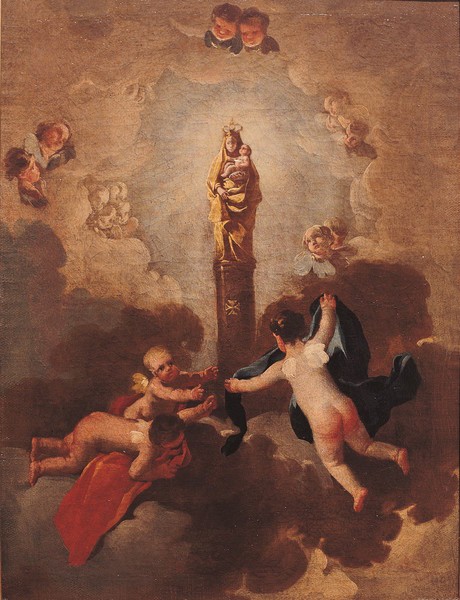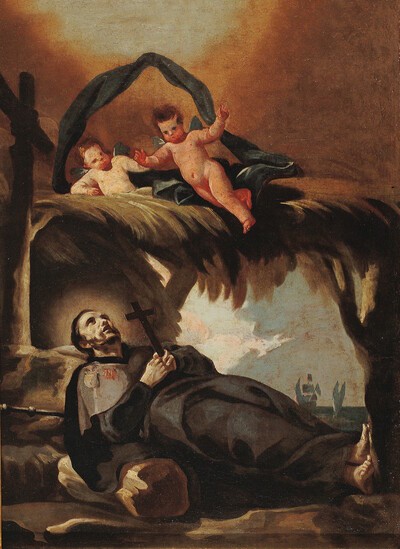- Cronología
- Ca. 1772 - 1775
- Ubicación
- Museum of Zaragoza, Zaragoza, Spain
- Dimensiones
- 56 x 42 cm
- Técnica y soporte
- Oil on canvas
- Reconocimiento de la autoría de Goya
- Documented work
- Titular
- Museo de Zaragoza
- Ficha: realización/revisión
- 07 Jan 2010 / 26 Feb 2025
- Inventario
- (9259)
This work was presumably created for one of Goya's relatives as a devotional painting. It was inherited by Ms. Francisca Lucientes, a descendent of his uncle Miguel, his mother's brother.
The Royal Academy of Noble and Fine Arts of San Luis acquired the canvas from the Lucientes family in 1926, together with another dedicated to the death of Saint Francis Xavier, and both works were entrusted to the Museum of Zaragoza.
From December 5th, 2024, and while the Zaragoza Museum remains closed for works, the painting is part of the exhibition 'Goya. From the Museum to the Palace' in the Aljafería Palace in Zaragoza.
The Virgin of the Pillar is placed at the centre of the composition, standing out against the ray of light which she herself is emitting. The painting has the air of a sketch, the shapes being described with the tip of the brush. The virgin is raised up on the holy column, surrounded by a host of putti which fly around her. Other little angel heads melt into the background, moving into grisaille tones and blurring into the clouds. The painting is dominated by pastel tones which sweeten the scene, giving it a rococo character.
A preparatory sketch for this painting can be found in the Italian Sketchbook, which proves its authenticity, although the artist did modify the original basic concept.
The painting has caused some confusion regarding its date and dimensions. The majority of studies record its dimensions as being 78 x 52 cm, when in fact the work is smaller than that. With regard to dating, Antonio Beltrán proposes a date of 1775-1780, Camón and Buendía bring that forward to 1773, while Gudiol believes this to be an earlier work from 1780-1781. Today, it is considered to have been completed in Zaragoza following the artist's return from Italy in 1771 but before his move to Madrid in 1775. This chronology is supported by the sketch found in the Italian Sketchbook.
In terms of the painting's provenance, its identical size and the similarities between the putti in this work and The Death of Saint Francis Xavier, also housed in the Museum of Zaragoza, suggest that they are a pair.
This painting underwent restoration work at the Institute of Conservation and Restoration of Cultural Property (ICRBC) in Madrid in 1982. The piece displayed severe craquelure and blistering in its layers which had caused the loss of some of the paintwork.
As a result, it was necessary to clean the image, allowing the recovery of the original tones, while the heads of two putti were reconstructed using the regattino technique.
-
Exposición de obras de Goya y de objetos que recuerdan las manufacturas artísticas de su épocaMuseo de ZaragozaZaragoza1928organized by la Real Academia de Nobles y Bellas Artes de San Luis in collaboration with the Junta del Patronato del Museo Provincial. April 1928cat. 462
-
Goya joven (1746-1776) y su entornoMuseo e Instituto Camón AznarZaragoza1986consultant editorl José Rogelio Buendía. November 21st to December 20th 1986cat. 33
-
Goya (1746 – 1828)Galleria Internazionale d’Arte Moderna di Ca’PesaroVenecia1989consultant editor Antonio Fortún Paesa. From May 7th to July 4th 1989cat. 10
-
GoyaLa Lonja, Torreón Fortea y Museo Pablo GargalloZaragoza1992consultant editor Julián Gállegocat. 5
-
Goya. El Capricho y la Invención. Cuadros de gabinete, bocetos y miniaturasMuseo Nacional del PradoMadrid1993from November 18th 1993 to February 15th 1994. Exhibited also at the Royal Academy of Arts, London, March 18th to June 12th 1994 and The Art Institute of Chicago, Chicago, July 16th to October 16th 1994, consultant editors Manuela B. Mena Marqués and Juliet Wilson-Bareaucat. 4
-
GoyaNationalmuseumStockholm1994consultant editors Juan J. Luna and Görel Cavalli-Björkman. From October 7th 1994 to January 8th 1995cat. 1
-
Goya en PonceMuseo de Arte de PoncePonce1995consultant editor María Luisa Cancela Ramírez Arellano. From May 13th to September 30th 1995
-
El Pilar es la Columna. Historia de una devociónLa LonjaZaragoza1995organized by Gobierno de Aragón and Diputación Provincial de Zaragoza. From October 7th 1995 to January 7th 1996
-
Realidad e imagen. Goya 1746 – 1828Museo de ZaragozaZaragoza1996consultant editor Federico Torralba Soriano. From October 3th to December 1st 1996cat. 11
-
Goya e ItaliaMuseo de ZaragozaZaragoza2008organized by the Fundación Goya en Aragóna, consultant editor Joan Sureda Pons. From June 1st to September 15th 2008cat. 200
-
Goya y Zaragoza (1746-1775). Sus raíces aragonesasMuseo Goya. Colección IbercajaZaragoza2015cat. 11
-
Goya. From the Museum to the PalaceZaragoza2024
-
Zaragoza2023cat. 68
-
Goya. From the Museum to the PalaceZaragoza2024cat.93
-
Vie et ouvre de Francisco de GoyaParísOffice du livre1970pp. 77, 91, cat. 172
-
BarcelonaPolígrafa1970vol. I, p. 252, cat. 112
-
L’opera pittorica completa di GoyaMilanRizzoli1974p. 94, cat. 66
-
Francisco de Goya, 4 vols.ZaragozaCaja de Ahorros de Zaragoza, Aragón y Rioja1980-1982vol. I, p. 62 y p. 81 (il.)
-
Goya. El capricho y la invención. Cuadros de gabinete, bocetos y miniaturasMadridMuseo del Prado1993pp. 112, 113, cat. 4 y p. 114 (il.)
-
Goya y Aragón. Familia, amistades y encargos artísticoscol. Col. Mariano de Pano y RuataZaragozaCaja de Ahorros de la Inmaculada de Aragón1995pp. 105, 107 y p.105 (il.)
-
Realidad e imagen. Goya 1746 – 1828MadridGobierno de Aragón y Electa España1996pp. 68-69, cat. 11
-
Museo de Zaragoza. GuíaZaragozaGobierno de Aragón2003p. 336 y p. 337 (il.)
-
Goya e Italia, 2 vols.ZaragozaFundación Goya en Aragón y Turner2008vol. II, p. 261, cat. 200
-
Goya y Zaragoza (1746-1775). Sus raíces aragonesasZaragozaFundación Goya en Aragón, Ibercaja y Gobierno de Aragón2015pp. 126-127
-
Yo soy Goya. La Zaragoza que viví. 1746-1775ZaragozaAyuntamiento de Zaragoza2023p.233
-
Goya. From the Museum to the PalaceZaragozaZitro Comunicación2024cat.92-93

